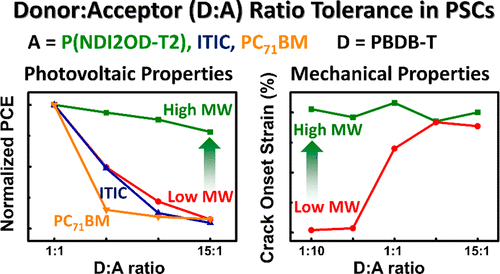当前位置:
X-MOL 学术
›
Chem. Mater.
›
论文详情
Our official English website, www.x-mol.net, welcomes your feedback! (Note: you will need to create a separate account there.)
Origin of the High Donor–Acceptor Composition Tolerance in Device Performance and Mechanical Robustness of All-Polymer Solar Cells
Chemistry of Materials ( IF 8.6 ) Pub Date : 2020-01-02 , DOI: 10.1021/acs.chemmater.9b04464 Jin-Woo Lee , Boo Soo Ma , Joonhyeong Choi , Junbok Lee , Seungjin Lee , Kin Liao 1 , Wonho Lee 2 , Taek-Soo Kim , Bumjoon J. Kim
Chemistry of Materials ( IF 8.6 ) Pub Date : 2020-01-02 , DOI: 10.1021/acs.chemmater.9b04464 Jin-Woo Lee , Boo Soo Ma , Joonhyeong Choi , Junbok Lee , Seungjin Lee , Kin Liao 1 , Wonho Lee 2 , Taek-Soo Kim , Bumjoon J. Kim
Affiliation

|
High tolerance regarding photovoltaic performance in terms of donor:acceptor (D:A) composition ratio is reported for all-polymer solar cells (all-PSCs), which is a crucial advantage in producing large-scale devices with high reproducibility. To understand the origin of high D:A ratio tolerance in all-PSCs, we investigate the molecular weight (MW) effects of the P(NDI2OD-T2) polymer acceptor (PA) on photovoltaic and mechanical robustness of PBDB-T:P(NDI2OD-T2) all-PSCs. Also, we compare the all-PSCs with other types of PSCs consisting of the same polymer donor but using small molecule acceptors (SMAs) including ITIC and PC71BM. We observe that the D:A ratio tolerances of both the photovoltaic and mechanical properties are highly dependent on the PA MW and the acceptor material types. For example, at a high D:A ratio of 15:1, all-PSCs using high MW PA (number-average molecular weight (Mn) = 97 kg mol–1) exhibit 13 times higher normalized power conversion efficiency (PCE) than all-PSCs using low MW PA (Mn = 11 kg mol–1), and 20 times higher than ITIC-based PSCs. In addition, the electron mobilities in all-PSCs based on high MW PA are well-maintained even at very high D:A ratio, whereas the electron mobilities in low MW PA all-PSCs and SMA-based PSCs decrease by 3- and 4-orders of magnitude, respectively, when the D:A ratio increases from 1:1 to 15:1. Thus, we suggest that the formation of tie molecules and chain entanglements by long polymer chains bridging adjacent crystalline domains is the main origin of excellent D:A tolerance in both mechanical robustness and photovoltaic performance. This work provides an important material design guideline for the reproducible production of flexible and stretchable all-PSCs.
中文翻译:

全聚合物太阳能电池在器件性能和机械强度方面的高供体-受体组成容差
据报道,对于全聚合物太阳能电池(all-PSC),在供体:受体(D:A)组成比方面,光伏性能具有较高的耐受性,这在生产具有高重现性的大型设备中具有至关重要的优势。为了理解高d的起源:在全的PSC的比率公差,我们研究的分子量(MW)的P(NDI2OD-T2)聚合物受体(的效应P甲)上的光伏和机械PBDB-T的鲁棒性:P (NDI2OD-T2)所有PSC。此外,我们将全PSC与其他类型的PSC进行了比较,这些PSC由相同的聚合物供体组成,但使用的是小分子受体(SMA),包括ITIC和PC 71 BM。我们观察到光伏和机械性能的D:A比容差高度依赖于P甲MW和受主材料的类型。例如,在高d:15:1的比例,使用高MW全的PSC P甲(数均分子量(中号Ñ)=97公斤摩尔-1)表现出13倍的归一化的功率转换效率(PCE )比使用低MW全的PSC P甲(中号ñ =11公斤摩尔-1)和20倍比基于ITIC-的PSC更高。此外,基于高MW在所有的PSC的电子迁移率P阿是在非常高的d甚至维护良好:A比值,而在低MW的电子迁移率P甲当D:A比率从1:1增加到15:1时,所有PSC和基于SMA的PSC分别降低3和4个数量级。因此,我们认为通过长聚合物链桥接相邻的晶域而形成键分子和链缠结是机械强度和光伏性能均具有出色的D:A耐受性的主要原因。这项工作为可重复生产的柔性和可拉伸全PSC提供了重要的材料设计指南。
更新日期:2020-01-04
中文翻译:

全聚合物太阳能电池在器件性能和机械强度方面的高供体-受体组成容差
据报道,对于全聚合物太阳能电池(all-PSC),在供体:受体(D:A)组成比方面,光伏性能具有较高的耐受性,这在生产具有高重现性的大型设备中具有至关重要的优势。为了理解高d的起源:在全的PSC的比率公差,我们研究的分子量(MW)的P(NDI2OD-T2)聚合物受体(的效应P甲)上的光伏和机械PBDB-T的鲁棒性:P (NDI2OD-T2)所有PSC。此外,我们将全PSC与其他类型的PSC进行了比较,这些PSC由相同的聚合物供体组成,但使用的是小分子受体(SMA),包括ITIC和PC 71 BM。我们观察到光伏和机械性能的D:A比容差高度依赖于P甲MW和受主材料的类型。例如,在高d:15:1的比例,使用高MW全的PSC P甲(数均分子量(中号Ñ)=97公斤摩尔-1)表现出13倍的归一化的功率转换效率(PCE )比使用低MW全的PSC P甲(中号ñ =11公斤摩尔-1)和20倍比基于ITIC-的PSC更高。此外,基于高MW在所有的PSC的电子迁移率P阿是在非常高的d甚至维护良好:A比值,而在低MW的电子迁移率P甲当D:A比率从1:1增加到15:1时,所有PSC和基于SMA的PSC分别降低3和4个数量级。因此,我们认为通过长聚合物链桥接相邻的晶域而形成键分子和链缠结是机械强度和光伏性能均具有出色的D:A耐受性的主要原因。这项工作为可重复生产的柔性和可拉伸全PSC提供了重要的材料设计指南。



























 京公网安备 11010802027423号
京公网安备 11010802027423号